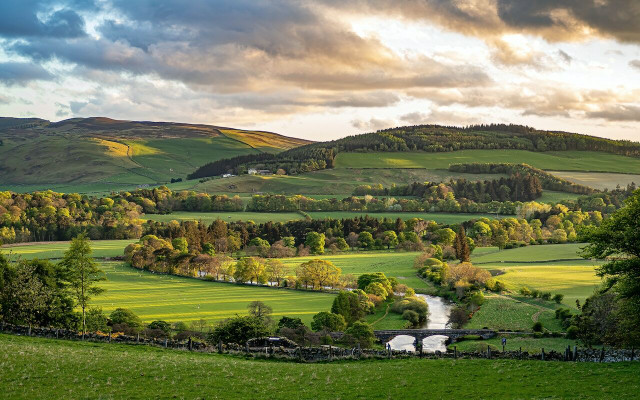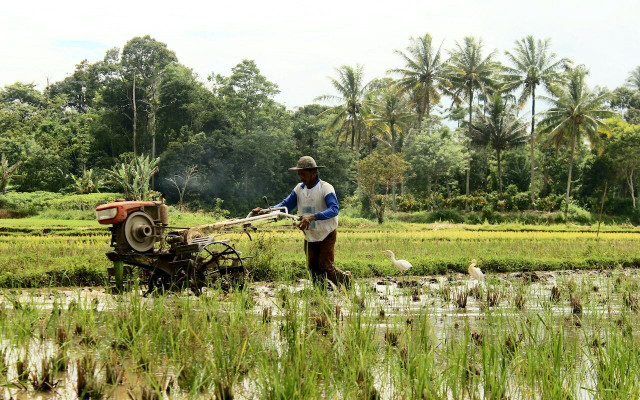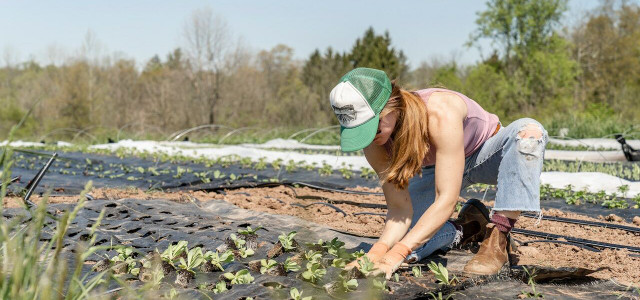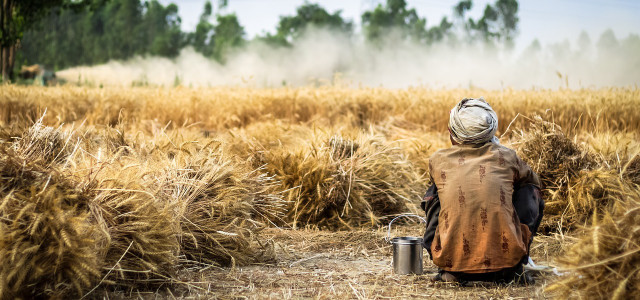Regenerative agriculture has the potential to be a game changer in the fight against climate change. Learn how this sustainable practice could help with global food security.
What if there was a solution that could bolster food security, combat climate change and restore soil health all at once? This is where the concept of regenerative agriculture comes in. It’s an approach that goes beyond just sustainable agriculture and farming practices; it’s about creating systems that restore and enhance the resources they use rather than deplete them.
Regenerative agriculture is more than just a buzzword in the conversation about our global food system. It’s a powerful tool that can feed our growing population and address environmental issues like climate change and soil degradation.
Read on to learn about regenerative agriculture, its principles and techniques and explore the benefits it could bring both humans and our planet.
What Is Food Security?
“Food security” is defined as ongoing, reliable access to enough nutritious food to maintain a healthy and active lifestyle. This involves both physical availability and economic affordability. In the United States, about 10.2% of households, or approximately 34 million people, encountered difficulties ensuring food security in 2021.
On a global scale, it is estimated that 828 million people were impacted by hunger in the same year. Regrettably, based on current forecasts, this figure is predicted to rise.
In fact, there isn’t a single country on the planet whose population is completely food secure.
Climate change is the single biggest threat to food security worldwide, though an increasing global population and overdependence on food imports and exports are also significant challenges. The climate crisis is responsible for changing weather patterns, compromising biodiversity and increasing the likelihood of extreme weather events such as hurricanes, droughts and floods.
What Is Soil Degradation?
Soil degradation is a critical factor contributing to food insecurity, largely because soil is an indispensable natural resource that is frequently undervalued. It not only filters water and sequesters vast quantities of carbon but also supports our ability to grow food and provides a natural barrier against flood and drought conditions.
Soil degradation encompasses the deterioration in physical, chemical and biological properties of soil, adversely affecting its quality and productivity. The causes of this degradation are diverse, but generally, they include:
- increasing salinity levels
- experiencing water or wind erosion
- depleting organic matter
- shifting towards extreme soil acidity or alkalinity
- contaminating soil with toxic chemicals and pollutants
You may also enjoy: The Save Soil Movement’s Origin, Impact and Intention
What Is Regenerative Agriculture?



Regenerative agriculture is a holistic approach to farming that gives back to the planet by rebuilding soil organic matter and restoring soil biodiversity. Instead of competing with nature the way conventional agriculture does, regenerative agriculture partners with it for mutual benefit.
The concept of regenerative agriculture is simple: it’s any form of farming that improves the environment. There are five main principles behind this type of farming, all of which boast numerous benefits.
The five main principles of regenerative agriculture are:
- Minimizing soil disturbance
- Keeping the soil covered with crops as long as possible
- Maximizing plant and animal biodiversity
- Adapting to the local environment
- Minimizing the use of pesticides, herbicides, chemical fertilizers, veterinary drugs and feed additives
Types of Regenerative Agriculture



Regenerative agriculture comprises several farming practices. They can be used on their own or in combination to maximize the benefits. You can even incorporate some of these techniques in your own home garden.
These are the types of regenerative agriculture:
- Silvopasture: Also known as forest farming, this method involves integrating the forest and animals together, instead of keeping them separate, consequently benefitting the land and the animals.
- Agroforestry: This practice integrates trees, shrubs and perennial plants into crop and livestock landscapes for added biodiversity.
- No-till: A method used in farming to help prevent soil erosion by growing crops without tilling the soil.
- Pasture Cropping: This involves planting the winter crops while the summer crops are still alive and thriving to eliminate fallow and bare ground.
- Compost: Organic matter is essential in creating good and fertile soil. Well-decomposed matter increases the water and nutrient-holding capacity of the soil, and components like grass clippings act as mulch to prevent weeds and lock in moisture. Nematodes do less damage in soil that is highly organic.
- Holistic Planned Grazing: This practice involves animals moving from paddock to paddock, mimicking the natural herding behavior of animals. In theory, this gives grass time to fully recover before being regrazed.
- Agroecology: While there is no universally acknowledged definition, agroecology is a science, social movement and set of agricultural practices that takes a holistic approach to farming.
- Biochar: Using biomass to create biochar that can be added to soils is another form of regenerative agriculture. This method can increase crop yields, reduce nutrient leaching, irrigation and fertilizer inputs and immobilize heavy metals. Biochar stores carbon sequestered from plants, reducing greenhouse gas emissions from soil.
- Perennial Crops: Perennial crops are excellent for the soil because they grow all year and can develop longer and more stabilizing roots than annual crops. They also don’t need to be replanted or reseeded the following year and are key to sequestering carbon in the soil.
- Companion Planting: This farming method can be easily integrated into any backyard garden. Companion planting involves growing different plants together that benefit one another and can reduce the need for herbicides, pesticides and synthetic fertilizers.
- Aquaculture: Approximately 71% of the planet’s surface is water, so regenerative agriculture isn’t limited to dry land. This farming practice can “farm” oysters, mussels, scallops and kelp to give back to marine environments.
- Crop Rotation: This farming practice returns nutrients to the soil without extra additives. It can interrupt pest and disease cycles and improve soil health.
Main Benefits of Regenerative Farming Practices



The benefits of regenerative agriculture make it a useful tool in the fight against climate change, one that should be given more consideration and attention. Among other advantages, it:
1. Helps reverse climate change
Governments worldwide are focused on reducing carbon emissions as a way to fight climate change. While this is a good place to start, emissions reduction alone isn’t good enough. By increasing soil carbon stocks, science indicates that we just might be able to reverse climate change.
2. Preserves traditional ecological knowledge
The understanding Indigenous people have of their environmental surroundings through traditional ecological knowledge enables them to take without being greedy and adapt based on what they see. Learning about Indigenous farming systems from people who truly know the land plays a key role in improving yields and properly utilizing the land.
3. Increases food security
Returning nutrients and organic matter to the soil increases the water-holding capacity and allows the land to have a higher yield. Studies have also shown that high plant diversity within agricultural plots can yield higher production levels than systems with low diversity. These practices can be implemented in small farms around the world, giving more people access to healthy food.
4. Nurtures biodiversity
There are three types of biodiversity, all of which are fundamental to agriculture production and environmental conservation. While there are many threats to biodiversity, regenerative agricultural practices help to preserve and nurture it.
5. Boosts local economies
Family farming provides the opportunity to boost local economies and increase food security at the same time. In developing countries, agriculture accounts for the majority of the labor force, making it a critical source of income. According to data from the Food and Agriculture Organization (FAO), there are over 500 million family farms worldwide that contribute to global food supplies.
6. Provides a potential solution to deforestation
Agriculture is responsible for up to 90% of deforestation around the globe. By adapting to and integrating with the surrounding land, the argument for cutting down trees to clear space for agricultural practices is no longer valid.
Challenges Facing Regenerative Agriculture



There are a number of challenges to implementing regenerative agricultural practices, particularly as certain aspects can seem counterintuitive compared to conventional farming methods.
- Time-consuming: It can take a long time to implement these practices fully, and it will be years before we see benefits and increased productivity. We can’t do anything about how long it will take, but farmers can take specific measures to see more results in the short term.
- Requires specialized knowledge and skills: Farming, in general, requires a lot of specialized knowledge, and some farmers find it difficult to learn new ways of doing things. Multiple organizations are currently making efforts to teach farmers the necessary skills.
- Difficult to implement on a large scale: Mass agriculture is based on monocultures, which go against regenerative agriculture practices. Crop rotation limits the variety of produce that can be grown at one time, and holistic grazing methods are unrealistic for large herds without having access to expansive plots of land.
- Fewer subsidies available: In many countries, farmers receive subsidies from the government depending on the type of crops and livestock they grow. The subsidization of agricultural products tends to only be available to those following conventional farming methods, so switching could result in a loss of income.
- Requires significant planning and organization: A holistic approach to agriculture requires a solid and well-thought-through plan. Crop rotations must be planned out to maximize yields — and trees, shrubs, and perennial plants must be selected and planted. Teaming up with other farmers interested in transforming their agricultural practices can alleviate some of the stress associated with planning and organization.
Advocates and Successful Projects



Despite the challenges facing regenerative agriculture, there are organizations that are making good use of the resources available to them and having a positive impact.
Advocates and Educators
Kiss the Ground is a non-profit based out of California focused on raising awareness for regenerative agriculture. They do this through education, story-telling and advocacy. They speak to farmers, Indigenous communities, ranchers and others involved in environmental stewardship to boost their voices.
Hailing from Australia, RegenAG is a community-based family enterprise that educates farmers, communities and other organizations about the benefits of regenerative agriculture. Their primary education methods include consultancy, Keynote talks, events, courses and workshops. You can read more about their successful case studies on their website.
Successful Projects
Paradise Farm in Sri Lanka was once-neglected farmland that has been completely transformed through regenerative agricultural practices. Over 800 plant species are grown here, including lucrative crops such as organic tea and organic virgin coconut oil.
Recently wrapped up in January of 2023, the FARMS4Biodiversity project is another success story. The goals of this project included improving food security, supporting ecosystems and biodiversity conservation in the Global South. It showed that agroecology improved food and seed security for farmers, and agroforestry provided valuable food for essential pollinators.
The success of Havhøst has sparked a lot of global interest in regenerative ocean agriculture. Maritime food gardens consisting of mussels, oysters and seaweed are popping up all over the coastlines of Denmark, improving biodiversity. This organization provides educational programs to teach people about the process and offer insight into sustainable food production.
The Rodale Institute in Pennsylvania was a champion of the farming practice before it became mainstream. The four-decade-long Farming Systems Trial proves that organic farm management matches or outperforms conventional agriculture in ways that benefit farmers and the planet.
Read more:
- Precision Fermentation: A Revolution in Food Production?
- Ranch vs. Farm: Differences, Similarities and Importance
- Bioeconomy: Growing the Economy with Renewable Resources
Do you like this post?











